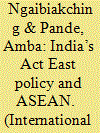| Srl | Item |
| 1 |
ID:
120795


|
|
|
|
|
| Publication |
2013.
|
| Summary/Abstract |
After the end of the Cold War, East Asia did not enter a period fraught with tension and conflict, but surprisingly maintained a relatively long period of peace. The existing literature on the East Asian security order mainly emphasizes structural or processual factors, but these approaches cannot provide an adequate explanation of the interior dynamics and mechanisms of the East Asian security order. The main reasons for the inherent instability in the current system are still unclear. In this paper, the author presents a functionalist explanation and argues that the United States and China's separate provision of the two most important public goods-security expectations and economic benefits-laid the foundation for the current security order in East Asia. However, with the rise of China and the U.S. pivot toward Asia, supplying these two types of regional public goods becomes more difficult than it was previously, and this new scenario will cause instability in the existing order.
|
|
|
|
|
|
|
|
|
|
|
|
|
|
|
|
| 2 |
ID:
170654


|
|
|
|
|
| Summary/Abstract |
Over the past few decades, India’s security concerns have undergone a substantial change. With the formulation of the Look East Policy (LEP) in the 1990s, the Association of Southeast Asian Nations (ASEAN) as a regional entity became an essential component and a corridor for India’s outreach to Southeast Asia. In 2014, the LEP became more encompassing with a shift to the Act East Policy (AEP). The global security and economic environment too are witnessing significant changes with the USA taking a back seat, China’s aggressive positioning and the Belt and Road Initiative (BRI) coupled with the emerging geopolitical construct of ‘Indo-Pacific’. The regional stakeholders, such as ASEAN, the USA, Japan, Australia and India are yet to form a unified stand on the Indo-Pacific concept as well as the regional security architecture. The AEP appropriately fits into the current scenario as India is set to take up a larger role in the regional security environment while keeping the centrality of ASEAN intact. New Delhi seeks to create a platform for mutual development in the Indo-Pacific and engage with like-minded nations in the quest for a rules-based order that promotes transparency, respect for sovereignty and international law, stability and free and fair-trade framework. India and ASEAN can be apt partners in the Indo-Pacific to play a constructive role and build a regional order.
|
|
|
|
|
|
|
|
|
|
|
|
|
|
|
|